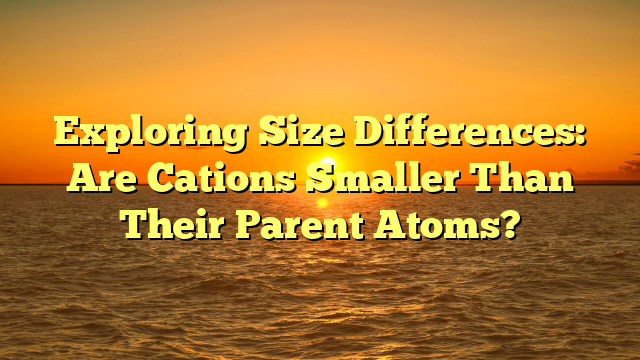Exploring Size Differences: Are Cations Smaller Than Their Parent Atoms?
Introduction
When it comes to understanding the properties of atoms and ions, size plays a crucial role. In this article, we will explore the concept of size differences between cations and their parent atoms. Cations are positively charged ions that are formed when an atom loses one or more electrons. It is commonly believed that cations are smaller than their parent atoms, but is this always the case? Let’s delve deeper into this topic and find out.
The Basics: Atomic Structure
Before we can discuss the size differences between cations and their parent atoms, it is important to understand the basics of atomic structure. Atoms consist of a nucleus, which contains protons and neutrons, surrounded by electrons in energy levels or shells. The number of protons in an atom determines its atomic number and defines the element. Electrons, on the other hand, are responsible for the chemical behavior of an atom.
Formation of Cations
When an atom loses one or more electrons, it becomes a cation. This loss of electrons results in a positive charge, as the number of protons now exceeds the number of electrons. Cations are formed through various processes, such as ionization or the transfer of electrons during chemical reactions. The resulting cation is smaller in size compared to its parent atom, but why does this happen?
Factors Affecting Size Differences
Several factors contribute to the size differences between cations and their parent atoms. These factors include:
- Electron-Electron Repulsion: In an atom, electrons repel each other due to their negative charges. When an electron is removed to form a cation, the repulsion between electrons decreases, causing the remaining electrons to be pulled closer to the nucleus. This contraction in electron cloud results in a smaller size for the cation.
- Nuclear Charge: The number of protons in the nucleus determines the nuclear charge. As the number of protons increases, the attractive force between the nucleus and the electrons also increases. This stronger attraction pulls the electrons closer to the nucleus, leading to a smaller cation size.
- Energy Levels: The loss of electrons during cation formation often occurs from the outermost energy level. Since the outermost energy level is farther from the nucleus, the removal of electrons from this level results in a decrease in size.
Exceptions to the Rule
While it is generally true that cations are smaller than their parent atoms, there are exceptions to this rule. Some transition metals, such as copper and zinc, can form cations that are larger than their parent atoms. This phenomenon is known as the “inert pair effect.” In these cases, the outermost s electrons are not lost during cation formation, leading to a larger size compared to the parent atom.
Experimental Evidence
Experimental evidence supports the concept of cations being smaller than their parent atoms. Various techniques, such as X-ray crystallography and electron microscopy, have been used to determine the sizes of atoms and ions. These studies consistently show that cations have a smaller atomic radius compared to their parent atoms.
Table: Comparison of Atomic Radii
| Element | Atomic Radius (pm) | Cation Radius (pm) |
|---|---|---|
| Lithium | 152 | 76 |
| Sodium | 186 | 102 |
| Potassium | 227 | 138 |
The table above provides a comparison of atomic radii and cation radii for selected elements. As evident from the data, the cation radius is significantly smaller than the atomic radius for each element.
Conclusion
In conclusion, cations are generally smaller than their parent atoms due to factors such as electron-electron repulsion, nuclear charge, and energy levels. The loss of electrons during cation formation leads to a contraction in the electron cloud and a decrease in size. While there are exceptions to this rule, experimental evidence consistently supports the concept of cations being smaller. Understanding the size differences between cations and their parent atoms is crucial for comprehending the behavior and properties of these ions in various chemical reactions.

